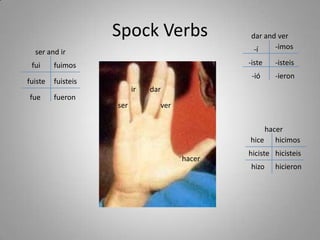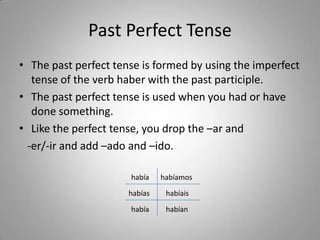Grammar book final
- 1. Spanish 3 Grammar ConceptsSancho Flynn
- 2. Table of Contents1. El Pretérito2. PreteriteTriggers3. Car, Gar, Zars4. SpockVerbs5. Snake Verbs6. SnakeyVerbs7. CucharachaIrregulars and Triggers8. El Imperfecto9. ImperfectTriggers10. ImperfectIrregulars11. Preterite vs. Imperfect12. Ser vs. Estar13. Verbs Like Gustar14. Comparatives/Superlatives15. Transition Words16. El Futuro17. Future Irregulars18. Future Trigger Words19. Por20. Para
- 3. El PretéritoHas a fixed point and timeHas a beginning and endEvents that happen a specific number of timesEvents that were part of a chain of eventsUsed for sudden changes in mood, feelings, or emotions-ar verbs-er /-ir verbs-é-amos-í-imos-aste-asteis-iste-isteis-ió-ieron-ó-aron
- 4. Preterite Trigger WordsThere are many triggers words that make it a little easier to distinguish when the preterite is being used including:Ayer, después, el mespasado, entonces, anoche, and el otrodía
- 5. Car, Gar, Zars-car verbs-gar verbs-qué-camos-gué-gamos-gaste-gasteis-caste-casteis-gó-garon-có-caron-zar verbs-cé-zamos-zaste-zasteis-zó-zaron
- 6. Spock Verbsdar and ver-imos-íser and ir-iste-isteisfuifuimos-ió-ieronfuistefuisteisirdarfuefueronserverhacerhicehicimoshicistehicisteishacerhizohicieron
- 7. Snake VerbsIrregular preterites that change only in 3rd person (he, she, it)Verbs change from e-i or o-uAn example for e-i would be decir which changes to dij-An example for o-u would be dormir which changes durm-
- 8. Snakey VerbsLike Snake Verbs, Snakey Verbs also change only in 3rd personVerbs change from i-y or e-yAn example for i-y would be oír which changes to oy-An example for e-y would be leer which changes to ley-
- 9. Cucaracha IrregularsExamples of thesewouldbe:Andar- anduv
- 10. Estar- estuv
- 11. Poder- pud
- 12. Poner- pus
- 13. Querer- quis
- 14. Saber- sup
- 15. Tener- tuv
- 16. Venir- vin-e-imos-iste-isteisAll end in:-o-ieron
- 17. El ImperfectoActions that were repeated habituallyFor telling timeFor stating one’s ageFor mental states (usually)For physical sensations (usually)To describe the characteristics of people, things or conditionsFor actions that “set the stage” for another past action-er/-ir verbs-ar verbs-íamos-aba-ábamos-ía-ías-íais-abas-abais-ía-ían-aba-aban
- 18. Imperfect Trigger WordsThere are a variety of imperfect trigger words including:a veces, a menudo, mientras, muchasveces, todos los días, and cadadía
- 19. Imperfect IrregularsAs shown below, ser, ir, and ver are all examples of irregular imperfect verbsserireraéramosibaíbamoseraseraisibasibaiseraeranibaibanverveíaveíamosveíasveíaisveíaveían
- 21. Ser vs. EstarSer is associated with the acronym DOCTOR PED which stands for:D: descriptionO: originC: characteristicsT: timeO: occupationR: relationshipP: possessionE: eventsD: datesEstar is associated with the acronym HELPING which stands for:H: healthE: emotionsL: locationP: present conditionING
- 22. Verbs Like GustarSome verbs like gustar are:Encantar: to loveMolestar: to botherFaltar: to lackFascinar: to fascinateApetecer: to wish forDisgustar: to disgustInteresar: to interest
- 23. Comparatives/SuperlativesThe formula for comparatives and superlatives are:más + adjective + que (más meaning more and que meaning than)Same thing for less than which is menos + adjective + queOther words for comparatives/superlatives are:Tan como (as…as), tantocomo (as much as), and el másThere are four irregulars in bueno, viejo, malo, and jovenbueno mejorviejo mayormalo peorjoven menor
- 24. Transition Words
- 25. El FuturoInfinitive + endingI, You, He/She, We, You All, They WILLThe endings are the same for -ar, -ir, and –erSer, ir, and estar are actually regular-é-emos-ás-éis-á-án
- 26. Future IrregularsDecir dirHacer harSalir saldrTener tendrValer valdrVenir vendrThe future of “Hay eshabrá” = There will bePoder podrQuerer querrSaber sabrCaber cabrHaber habr
- 27. Future Trigger WordsEn ___días, horas, semanas, añosEl proximodía, hora, semana, añoMañana, or any day of the to come
- 28. PorPassing through… PORtalGeneral rather than specific location… PORtugalHow long something lasts… POReverThe cause of somethingAn exchange… imPORt/exPORtDoing something in place of or instead of someone else… I’m POR, pay for meA means of transportation… transPORtation
- 29. ParaFor whom something is done… surprise PARAtyDestination… PARAguayThe purpose for which something is done… PARAsitesTo express an opinion… PARAdon me, butTo contrast or comPARATo express idea of deadline… PARAmedic
- 30. Grammar Book Part 2Sancho Flynn
- 31. Conditional & IrregularsConditional TenseIrregularsThe conditional is often used to express probability, possibility, and wonder and is usually understood to be would, could, must have or probably. Here is the suffix you would add onto –ar, -er, and –ir verbs:There are 12 irregular verbs in theconditional tense.They are: caber (cabr-), poner (pondr-), decir (dira-) haber (habr-), salir (saldr-), hacer (har-), poder (podr-), tener (tendr-), querer (querr-), valer (valdr-), saber (sabr-), and venir (vendr-).íaíamosíasíaisíaían
- 32. The perfect tense is compound, formed with the verb haber and the past participle of another verb.-ar verbs go to –ado; -er/-ir verbs go to –idoThe action was completed recently.The perfect tense is true in both the past and the present.Perfect Tensehehemoshashabeishahan
- 33. Poner puestoAbrir abiertoHacer hechoCubrir cubiertoMorir muertoEscribir escritoVolver vueltoDecir dichoIr idoRomper rotoVer vistoResolver resueltoPerfect Tense Irregulars
- 34. The past perfect tense is formed by using the imperfect tense of the verb haber with the past participle.The past perfect tense is used when you had or have done something.Like the perfect tense, you drop the –ar and -er/-ir and add –ado and –ido.Past Perfect Tensehabíahabíamoshabíashabíaishabíahabían
- 35. The subjunctive perfect tense is usually used to indicate that an action was completed with verbs in the present or perfect tense.Used in the same types of clauses as the present subjunctive.Present subjunctive + past participleSubjunctive Perfect TensehayahayamoshayashayáisPast participlehayahayan
- 36. We use ‘se’ to avoid specifying who is doing the action.The verb is always in the 3rd person when using ‘se.’For example:Se vende pan en el supermercado. Impersonal Se
- 37. SaberUsed to express factual information.Yo no sé tu número de teléfono.ConocerAssociatedwithbeingunfamiliarwith a person, place, orobject.Yo no conozco a Sancho.Saber vs. Conocer
- 38. Tan is used with adjectives and adverbs.tan + adjective (adverb) + comoWe are familiar with the phrase: tan…como (as…as)Example: El libro es tan bueno como la película.Tanto is associated with nouns and adverbs.tanto(-a,-os,-as) + noun + comoWe are familiar withthephrase: tanto…como (as many/much…as)Example: Juan tiene tanto dinero como María.Tan & Tanto
- 39. Affirmative:Conjugate to the 3rd person endings: ar (a), er/ir (e)Hablar habla Comer come escribir escribeNegative:Conjugate to the tú form: ar (es), er/ir (as)Hablar no hables Comer no comas Escribir no escribasIrregulars: di, haz, ve, pon, sal, sé, ten, venDOP/IOP: DOPs must be attached to the end of the affrimative command, and they must be placed in front of the command if it’s a negative command. Example: Cómpralas, No lascompresIOPs must be placed in front of DOPs when attached to the affirmative command and when it’s a negative command.Example: Compramelo, No me lo compresInformal Commands
- 40. Formal CommandsUsted:Conjugate to the yo form, drop the O, and add the opposite ending: ar (e), er/ir (a)Ex: hablar hable comer coma escribir escribaUstedes:Conjugate to the yo form, drop the O, and add the opposite ending of the third plural form: ar (en), er/ir (an)Ex: hablar hablen comer comanescribir escriban
- 41. Go to the yo form of the verb, drop the O and add the opposite nosotros form ending:Comemos comamosMono Verbs:When you are making the verb reflexsive for nos, you drop the sComemosnos ComemonosNosotros Commands
- 42. Indicative- facts, real, definiteMood- attitudes, uncertainty, hypotheticalPut it in the yo form and change it to the opposite ending: hablar hable, hables, hable, hablemos, hableís, hablenQueconnects clausesWhen there is no change in subject from clause to clause, use infinitives.Subjunctive
- 43. Car, gar, zar are the same they always are:Conducir conduzcaDecir digaJugar juegueAlmorzar almuerceOther irregulars are dar, estar, and saber.Hay hayaSubjunctive Irregularsdardédemosdesdeísdenden
- 44. Impersonal Expressions:Es buenoque, esmaloque, esmejorque, esimportanteque, esnecesarioque, esurgentequeAll express a need, an order, or a desireExpressions of Emotion:Sentirque, alegrarseque, temerque, esperarqueAll express fear, joy, anger, regret, happiness, surprise, and pitySubjunctive Trigger Phrases
- 45. Serve the same function as they do in English (obviously)They are:Este(a) (this), estos(as) (these)Ese(a) (that), esos(as) (those)Aquel(la) (that _ over there), aquellos(as) (those _ over there)Demonstrative Adjectives & Pronouns





































